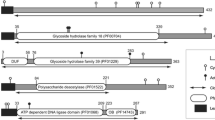Abstract
Host cell physiology is known to play a crucial role in the expression of foreign genes in heterologous systems. Expression of archaeal genes in anaerobic or semi-anaerobic growth conditions of E. coli has been previously reported to be a means of improving solubility of some proteins. Here, we report that some of the Rosetta strains of E. coli, which harbour the rare tRNA genes for the expression of archaeal genes, favour semi-anaerobic conditions for the expression of putative FMN binding domain of glutamate synthase from Methanocaldococcus jannaschii at low inducer concentrations.
Similar content being viewed by others
References
MA Vanoni B Curti (2005) Arch. Biochem. Biophys. 433 193–211 Occurrence Handle10.1016/j.abb.2004.08.033 Occurrence Handle1:CAS:528:DC%2BD2cXhtVCgtL7I Occurrence Handle15581577
A Suzuki DB Knaff (2005) Photosynth. Res. 83 191–217 Occurrence Handle10.1007/s11120-004-3478-0 Occurrence Handle1:CAS:528:DC%2BD2MXhslGntrc%3D Occurrence Handle16143852
Hirel B & Lea PJ (2003) In: Foyer CH & Noctor G (Eds.) Photosynthetic Nitrogen Assimilation and Associated Carbon and Respiratory Metabolism (pp. 69–92) Kluwer Academic Publishers, Dordrecht.
MA Vanoni DE Edmondson G Zanetti GB Curti (1992) Biochemistry 31 4613–4623 Occurrence Handle10.1021/bi00134a011 Occurrence Handle1:CAS:528:DyaK38XitlSlu7k%3D Occurrence Handle1316154
F Navarro S Chávez S Candau FJ Florencio (1995) Plant. Mol. Biol. 27 753–767 Occurrence Handle10.1007/BF00020228 Occurrence Handle1:CAS:528:DyaK2MXlt1Wnu7s%3D Occurrence Handle7727752
C Binda RT Bossi S Wakatsuki S Arzt A Coda B Curti MA Vanoni A Mattevi (2000) Structure 8 1299–1308 Occurrence Handle10.1016/S0969-2126(00)00540-2 Occurrence Handle1:CAS:528:DC%2BD3MXhtFent7w%3D Occurrence Handle11188694
RH Heuvel D Ferrari RT Bossi S Ravasio B Curti MA Vanoni FJ Florencio A Mattevi (2002) J. Biol. Chem. 277 24579–24583 Occurrence Handle11967268
S Ravasio L Dossena EM Figuerosa FJ Florencio A Mattevi P Morandi B Curti MA Vanoni (2002) Biochemistry 41 8120–8133 Occurrence Handle10.1021/bi020083r Occurrence Handle1:CAS:528:DC%2BD38XjvFahu78%3D Occurrence Handle12069605
CJ Bult O White GJ Olsen L Zhou RG Fleischmann GG Sutton JA Blake GA FitzGerald RA Clayton JD Gocayne AR Kerlavage BA Dougherty JB Tomb MD Adams CI Reich R Overbeek EF Kirkness KG Weinstock JM Merrick A Glodek JL Scott NSM Geoghagen JF Weidman JL Fuhrmann D Nguyen TR Utterback JM Kelley JD Peterson PW Sadow MC Hanna MD Cotton KM Roberts MA Hurst BP Kaine M Borodovsky HP Klenk CM Fraser HO Smith CR Woese JC Venter (1996) Science 273 1058–1073 Occurrence Handle1:CAS:528:DyaK28XltFKrsrs%3D Occurrence Handle8688087
HB Dincturk DB Knaff (2000) Mol. Biol. Rep. 27 141–148 Occurrence Handle10.1023/A:1007107909619 Occurrence Handle1:CAS:528:DC%2BD3MXhslGrt70%3D Occurrence Handle11254103
GJ Schut SD Brehm S Datta MWW Adams (2003) J. Bacteriol. 185 3935–3947 Occurrence Handle10.1128/JB.185.13.3935-3947.2003 Occurrence Handle1:CAS:528:DC%2BD3sXltFems7Y%3D Occurrence Handle12813088
B Jongsareejit RNZA Rahman S Fujiwara T Imanaka (1997) Mol. Gen. Genet. 254 635–642 Occurrence Handle1:CAS:528:DyaK2sXksFSkt7g%3D Occurrence Handle9202379
F Sambrook EF Fritsch T Maniatis (1989) Molecular Cloning Cold Spring Harbour Laboratory Press New York
UK Laemmli (1970) Nature 22 680–685
MM Bradford (1976) Anal. Biochem. 72 248–254 Occurrence Handle10.1016/0003-2697(76)90527-3 Occurrence Handle1:CAS:528:DyaE28XksVehtrY%3D Occurrence Handle942051
Y Kashima K Ishikawa (2003) J. Biochem. 134 25–29 Occurrence Handle10.1093/jb/mvg109 Occurrence Handle1:CAS:528:DC%2BD3sXnslGlurw%3D Occurrence Handle12944367
R Kim SJ Sandler S Goldman A Yokota AJ Clark S-H Kim (1998) Biotech. Lett. 20 207–210 Occurrence Handle1:CAS:528:DyaK1cXit1entro%3D
HW Jannasch MJ Mottl (1986) Science 229 717–725
JB Broderick TF Henshaw J Cheek K Wojtuszewski SR Smith MR Trojan RM McGhan A Kopf M Kibbey WE Broderick (2000) Biochem. Biophys. Res. Commun. 269 451–456 Occurrence Handle10.1006/bbrc.2000.2313 Occurrence Handle1:CAS:528:DC%2BD3cXhsFKhsro%3D Occurrence Handle10708574
Author information
Authors and Affiliations
Corresponding author
Rights and permissions
About this article
Cite this article
Demir, V., Dincturk, H.B. Semi-anaerobic Growth Conditions are Favoured by some Escherichia coli Strains During Heterologous Expression of Some Archaeal Proteins. Mol Biol Rep 33, 59–63 (2006). https://doi.org/10.1007/s11033-005-5067-5
Accepted:
Issue Date:
DOI: https://doi.org/10.1007/s11033-005-5067-5




